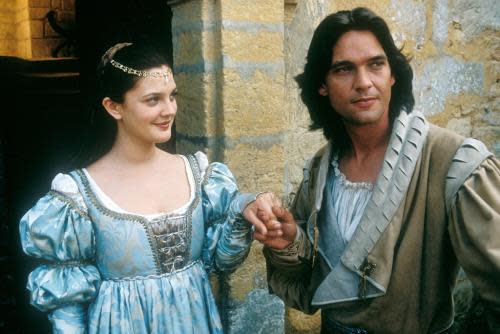What to Stream: Drew Barrymore's Revolutionary Cinderella Story 'Ever After'

Drew Barrymore and Dougray Scott in ‘Ever After’
Ever After (1998)
The Basics: Drew Barrymore plays a version of Cinderella in the classic fairy tale, which is re-invented as a funny, forward-thinking period romance.
If You Liked: The Princess Bride, Tangled, and Emma
Disney’s new Cinderella (in theaters Friday) updates the animated classic with live action, digital effects, and a newly empowered heroine. But this isn’t the first time the glass-slipper story has been given a feminist slant. In 1998, Drew Barrymore revolutionized the Cinderella tale in Ever After, a film that gives depth and strength to its fairy-tale princess without sacrificing an ounce of charm. What’s most unusual about Ever After is what it does sacrifice: the whole idea of magic.
Related: Cinderella as Superhero: How the Timeless Heroine Keeps Casting Her Spell
Directed by Andy Tennant (Hitch), with a screenplay co-written by Susannah Grant (Erin Brockovich), Ever After transports the Cinderella story to Renaissance-era France. Barrymore plays Danielle, whose blissful childhood came to an end when her widowed father re-married and promptly died of a heart attack. At age 18, she is now a servant on her family’s farm where she’s treated badly by her domineering stepmother Baroness Rodmilla de Ghent (the incomparable Anjelica Huston) and her stepsisters Marguerite and Jacqueline (Megan Dodd and Melanie Lynskey, both hilarious). Instead of pouring her heart out to pet mice, Danielle finds companionship in nature, books, and her fellow servants. And then there’s Prince Henry (would-be Wolverine Dougray Scott), who hates his life in the castle and has taken to roaming the countryside on horses stolen from peasants. He makes the mistake of attempting to steal one from Danielle, who lobs an apple at him. And so their love story begins.
Unlike other Cinderella stories, the royal ball is not the centerpiece of Ever After. Instead, the essential elements of that scene — Cinderella disguises herself as an aristocrat, the prince is smitten, she runs away, and the whole thing repeats — are cleverly woven throughout the film. Danielle first tries to pass as a courtier so that she can buy back the freedom of a family servant who has been sold by her stepmother. At the castle, she engages in a full-on debate about class structure with Prince Henry, who doesn’t recognize her as the apple thrower and is smitten by her passion (and her ability to quote Thomas More’s Utopia). She runs away before he can ask too many questions, but continues the ruse when she and the prince are reunited by the film’s version of a fairy godmother: Leonardo Da Vinci.
Yes, that Leonardo Da Vinci. Instead of magical spells and transforming pumpkins, Ever After summons its happy ending through the Renaissance ideals of science, art, and learning — and who better to embody these than the man who painted the Mona Lisa? In the film, Da Vinci (a visiting guest of the palace) spends his days tromping around the kingdom with Prince Henry, testing out whimsical inventions like “boat shoes” and urging the prince to marry for love, not politics. Played by Patrick Godfrey, this character bears little if any resemblance to the historical Da Vinci (who wasn’t even alive during the film’s designated time period, as many IMDb annotators have noted).
But Ever After isn’t concerned with historical accuracy. This is history painted as myth, and Leonardo represents a bigger way of thinking about the world than “haves” and “have nots.” Therein lies the genius of removing magic from the story: In the usual narrative, Cinderella transforms instantly and painlessly from peasant to princess. Ever After takes away that trick, and forces its characters to grapple with the very real difficulty of communicating across class barriers.
But fear not, fairy-tale purists: All of this does culminate in a ballroom, and a scene in which the prince kneels at Danielle’s feet with a glass slipper. The difference is that when Prince Henry arrives to rescue Danielle, he discovers that she has already rescued herself. Back in 1998, this seemed like the anti-Disney interpretation of Cinderella. Who knew that 17 years later, the mouse would finally come around?
Ever After is available on Netflix Instant, iTunes, Amazon Instant, and Google Play
Watch the trailer:
